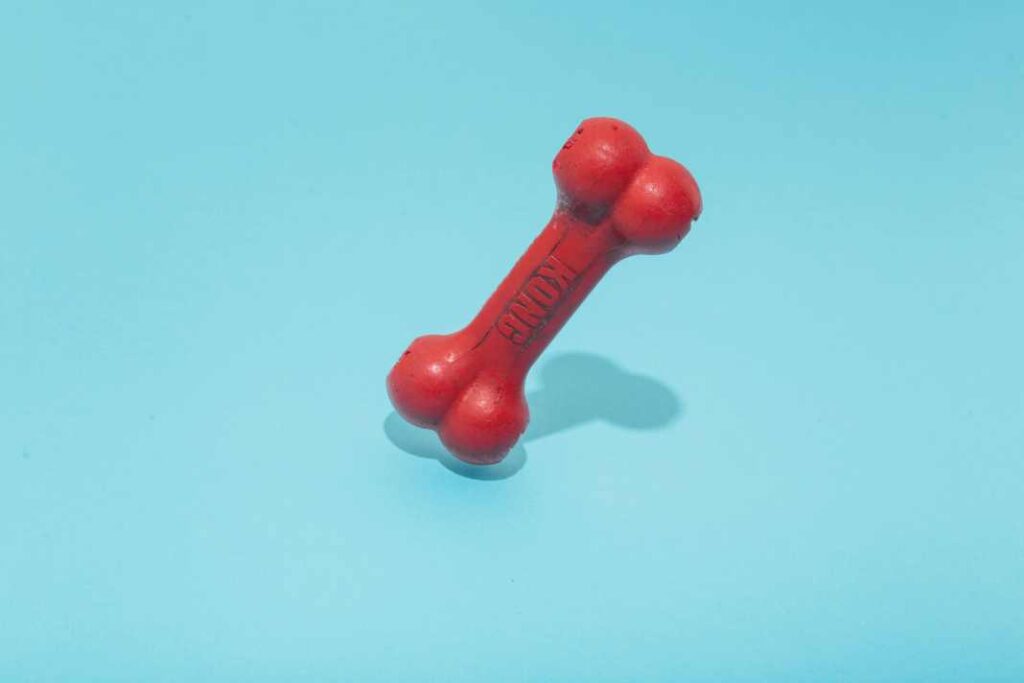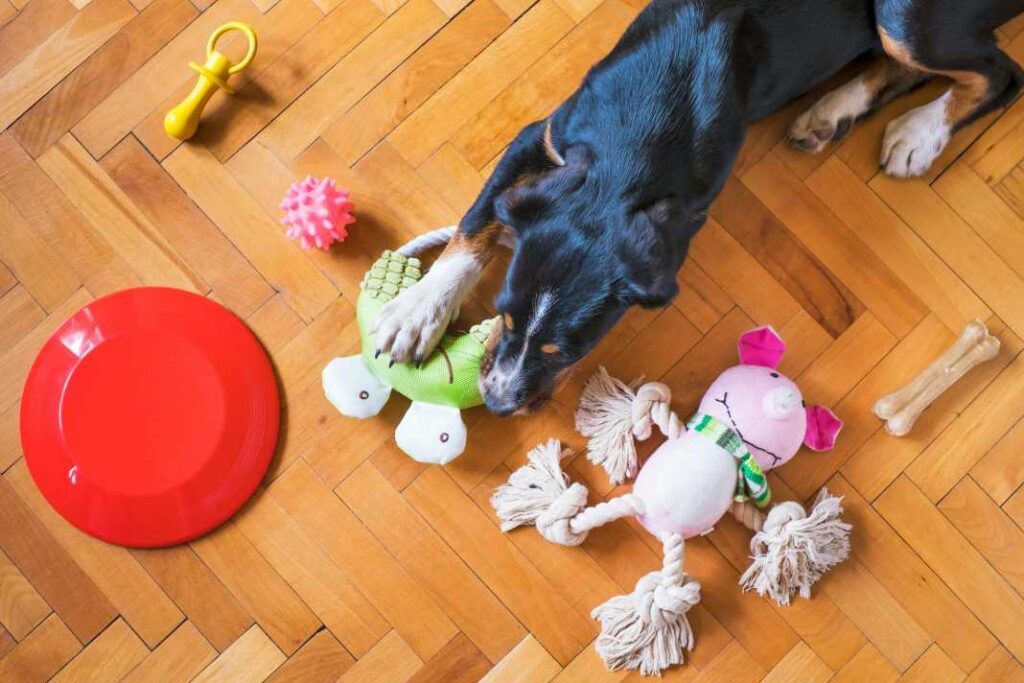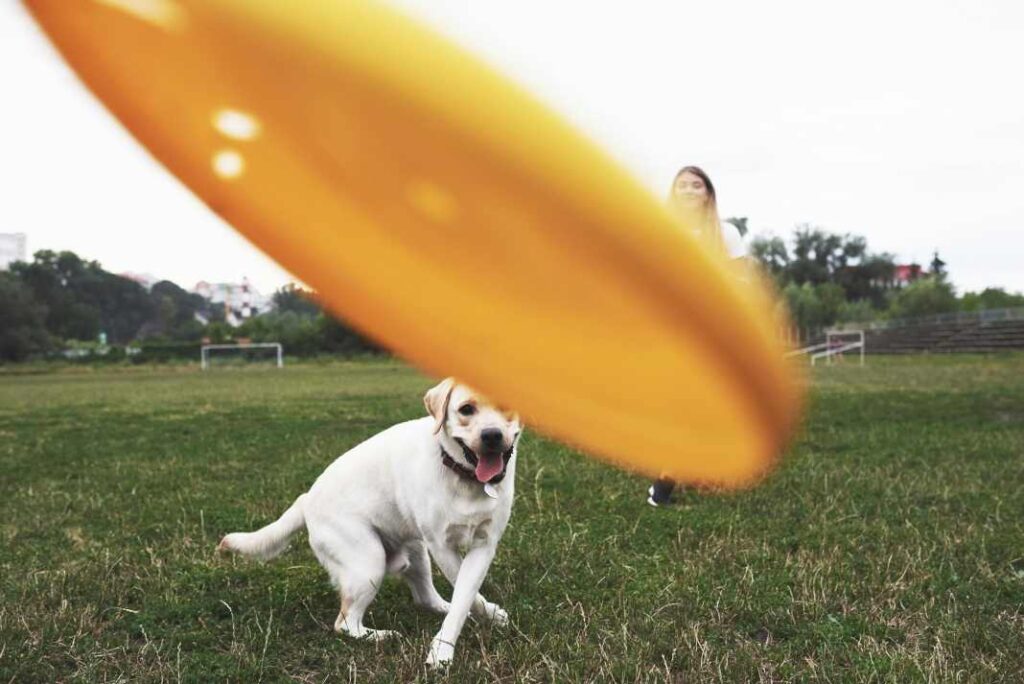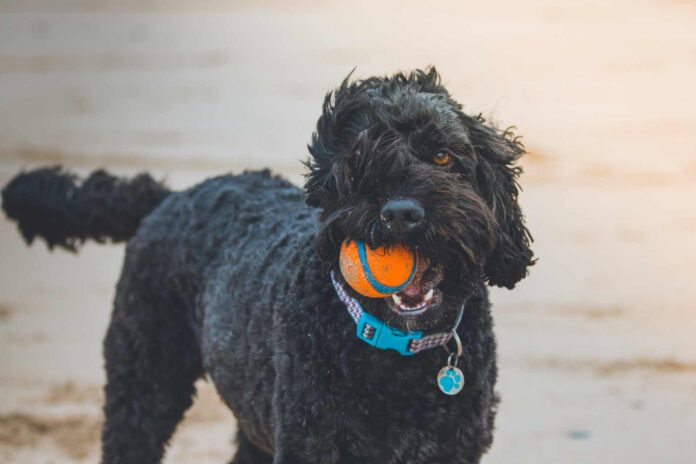The article explores the role of toys in puppy training and behavior, highlighting how toys can enhance puppy training and provide mental stimulation, prevent destructive behaviors, and enhance the human-animal bond.
Introduction to the Role of Toys in Puppy Training and Behavior
Toys are not merely playthings but are essential tools in the developmental journey of a puppy, serving multiple purposes that extend far beyond entertainment. They play a critical role in mental stimulation, helping to ward off potential behavioral problems before they start.
This early intervention is crucial in shaping a puppy into a well-mannered adult dog, capable of navigating the complexities of its environment with ease. Moreover, interactive toys have a profound impact on the relationship between puppies and their owners.
These toys facilitate engaging activities that strengthen the emotional bond, making training sessions not just educational but also enjoyable for both parties involved.
The strategic use of toys in training harnesses a puppy’s natural inclinations towards play, turning routine learning into a captivating experience. Such an approach not only makes the training process more enjoyable but also enhances the effectiveness of the lessons being taught.
As an Amazon Associate, I earn from qualifying purchases. When you purchase products through the links on this page, I may earn a small commission at no extra cost to you.
Puppies are more likely to retain commands and desired behaviors when they are learned in a context that is stimulating and rewarding. For instance, incorporating a toy like a Kong, filled with treats, can transform a simple training task into a fun and challenging activity that keeps a puppy engaged and eager to learn.
This dynamic interplay between play and learning underscores the indispensable role that toys play in fostering a positive and enriching training environment, laying the groundwork for a puppy’s long-term behavioral health and well-being.

The Importance of Toys in Puppy Training
Toys serve as an indispensable component in the multifaceted process of puppy training, playing a pivotal role beyond just entertainment. They provide a constructive avenue for puppies to channel their seemingly inexhaustible energy, thus mitigating the risk of engaging in undesirable behaviors.
For instance, the act of chewing, a natural instinct for puppies, can lead to the destruction of household items if not properly directed. Chew toys, specifically designed to withstand and encourage this behavior, can prevent puppies from turning their attention to furniture, shoes, or other inappropriate objects, thereby safeguarding the home environment while satisfying their innate need to chew.
Puzzle toys also sharpen their minds, making training a rewarding game.
Moreover, toys are instrumental in the cognitive development and mental stimulation of puppies. They introduce an element of challenge and engagement, which is crucial in preventing boredom and anxiety.
Puzzle toys, for example, require puppies to solve simple problems to receive a reward, fostering their problem-solving skills and cognitive abilities. This type of mental exercise is as vital as physical activity in the overall development of a puppy, aiding in the growth of a well-rounded and behaviorally sound dog.
By incorporating a variety of toys into training sessions, puppies are exposed to diverse stimuli, promoting adaptability and a keenness to learn. The strategic use of toys in training, such as employing them as rewards for good behavior or as tools to demonstrate and reinforce commands, enhances the training experience, making it more enjoyable and effective for both the puppy and the trainer.

Types of Toys Beneficial for Puppy Training
Toys serve not just as entertainment but as essential tools in the developmental journey of a puppy, aiding both in training and in fostering a well-balanced behavior.
Among the vast array of toys, interactive toys, such as puzzle feeders and treat-dispensing toys, take a prominent place by engaging a puppy’s mind and rewarding them for their efforts, thus reinforcing positive behavior.
As an Amazon Associate, I earn from qualifying purchases. When you purchase products through the links on this page, I may earn a small commission at no extra cost to you.
For example, a Kong Wubba, which combines the fun of a tug toy with the challenge of a treat dispenser, encourages puppies to solve the puzzle of retrieving the treat, thereby keeping them mentally stimulated and focused.
In addition to interactive toys, soft toys, and water toys play a crucial role in a puppy’s life. Soft toys, like plush animals, offer more than just comfort; they can act as a companion for puppies during times of anxiety or separation, providing a sense of security and well-being.
On the other hand, water toys, including floating toys or those designed to be frozen, introduce puppies to different types of play and environments.
Such toys not only serve as a refreshing way to cool down during hot days but also encourage physical exercise and can be particularly beneficial for breeds that are naturally drawn to water.
By integrating a variety of toys into a puppy’s routine, owners can ensure a comprehensive approach to training that addresses both mental and physical development.
Using Toys for Positive Reinforcement in Puppy Training
Understanding and catering to a puppy’s individual preferences plays a vital role in the effectiveness of using toys for positive reinforcement in training. Different breeds and even individual puppies within the same breed may show varying degrees of interest in specific types of toys.
For instance, a Border Collie, known for its high energy and intelligence, might be more engaged with puzzle toys or toys that require a chase, such as frisbees. Incorporating these toys into training sessions can significantly enhance the learning experience, making it more enjoyable and stimulating for the puppy.
By rewarding puppies with their preferred toys for obeying commands or exhibiting desirable behaviors, we not only reinforce these behaviors but also build a deeper connection between the puppy and its owner.
Tailor toy training to your pup’s unique style. It’s playtime with a purpose!
The strategic use of toys in training goes beyond just providing entertainment; it serves as a powerful tool for behavior modification. For example, chew toys like Goughnuts can be particularly effective in redirecting a puppy’s chewing behavior from inappropriate objects, such as furniture, to something more suitable.
This redirection technique, combined with the positive reinforcement of rewarding the puppy with playtime or a favorite toy, like the KONG Wubba, for making the right choice, encourages the puppy to repeat those positive behaviors in the future. Moreover, engaging in play with these toys can help to strengthen the bond between puppies and their owners, fostering trust and cooperation.
By thoughtfully selecting toys that align with a puppy’s natural tendencies and preferences, trainers and owners can enhance the training process, making it more effective and mutually rewarding.
Understanding Puppy Behavior and Toys
Puppies, with their boundless energy and curiosity, often form strong attachments to their toys. This attachment can sometimes manifest as possessive behavior, indicating a critical opportunity for pet owners to introduce training focused on sharing and socialization.
Such behaviors not only highlight the importance of toys in a puppy’s life but also underscore the need for careful observation and intervention by owners to ensure these behaviors do not escalate into aggression or resource guarding.
Toys that mimic natural instincts, like the squeaky toys that appeal to the prey drive of hunting breeds, serve a dual purpose. They not only entertain but also provide a deep sense of satisfaction and fulfillment by engaging a puppy’s natural instincts.
Toys are a pup’s treasure—handle with care! 🐶✨ Strong attachments can lead to possessiveness, a chance to teach sharing.
The way puppies interact with their toys can be a window into their personality and preferences. For example, a puppy that prefers interactive toys, such as a Kong Wubba, which can be thrown, tugged, and chewed, may have a high energy level and benefit from more active playtime and training sessions that incorporate physical activities.
Conversely, a puppy that gravitates towards comfort toys, like soft plushies, may need more reassurance and could respond well to training that emphasizes security and comfort, especially during periods of separation or anxiety.
Therefore, observing and understanding a puppy’s behavior with toys is not just about ensuring they are entertained; it’s about crafting a tailored approach to training and enrichment that aligns with their individual needs and encourages healthy development.

Preventing Destructive Behavior Through Proper Toy Usage
Preventing destructive behavior in puppies starts with understanding their need for mental and physical stimulation. A common reason behind destructive chewing and other unwanted behaviors is simply boredom or excess energy.
By providing a diverse selection of toys, puppies are less likely to turn their attention to household items like shoes or furniture. Toys designed with various textures, such as rubber chew toys, soft plushies, and crinkly materials, can captivate a puppy’s interest in multiple ways.
For instance, the Kong Wubba, with its unique combination of a squeaker and durable fabric tails, offers both chew and tug-play options, appealing to a wide range of puppy preferences.
Rotate their toys to keep interest peaked and integrate brain games for mental fun.
To further enhance engagement and reduce the likelihood of toy fatigue, implementing a rotation system for your puppy’s toys can be highly beneficial. This means not all toys are available at once; instead, a selection is made available for a certain period, and then swapped out for others in the collection.
This strategy keeps each toy novel and exciting for the puppy, renewing their interest and reducing the chance they will seek out less appropriate items for entertainment. Additionally, toys that encourage interactive play, such as automatic ball launchers or puzzle feeders, not only keep puppies entertained but also stimulate their minds, making playtime both fun and educational.
By thoughtfully selecting and rotating toys, owners can create a stimulating environment that nurtures their puppy’s development while steering them away from potentially destructive behaviors.
As an Amazon Associate, I earn from qualifying purchases. When you purchase products through the links on this page, I may earn a small commission at no extra cost to you.
Tips for Effectively Using Toys in Puppy Training Sessions
Toys are not merely playthings but powerful tools in the toolbox of puppy training. When used effectively, they can transform obedience training from a mundane task into an exciting game that puppies look forward to.
For instance, a game of fetch can be a reward for sitting on command, turning a basic obedience task into a fun activity. This method not only reinforces the desired behavior but also strengthens the bond between owner and puppy, as they engage in a mutually enjoyable activity.
The key to success lies in identifying the toys that your puppy values most, which can vary widely among individuals. Some may prefer a squeaky plush toy, while others might find a tug rope more enticing. Observing your puppy’s play preferences and incorporating these favored toys into training sessions can significantly enhance their motivation and participation.
Tailor the toy to your pup’s joy for eager learning.
Moreover, the way toys are used during training sessions can provide valuable insights into a puppy’s emotional state and behavioral tendencies. For example, a puppy showing reluctance to release a toy during a game of tug could be exhibiting early signs of possessiveness.
Timely recognition of such behaviors allows for the introduction of commands like “drop it” within a positive, reward-based framework, promoting good habits and preventing potential issues.
It’s also essential to monitor the puppy’s reactions to different toys, as signs of discomfort or aggression could indicate a deeper issue that needs to be addressed.
Adjusting the training approach based on these observations, such as introducing softer or more interactive toys, can create a more supportive learning environment.
By carefully selecting and strategically using toys in training sessions, owners can foster a positive learning atmosphere that encourages good behavior, mitigates potential problems, and enriches the puppy’s training experience.
Concluding Remarks on How Toys Can Enhance Puppy Training
Toys are far more than simple playthings; they are essential instruments in the development and training of puppies, offering both mental stimulation and a conduit for strengthening the bond between pets and their owners.
The strategic selection and use of toys in training sessions can dramatically enhance the effectiveness and enjoyment of these experiences for both parties involved. For instance, a puzzle feeder not only keeps a puppy engaged but also encourages problem-solving skills, turning mealtime into an interactive learning opportunity.
By closely observing how a puppy interacts with different toys, owners can glean valuable insights into their pet’s preferences, strengths, and areas needing improvement. This understanding allows for the tailoring of training methods to suit the individual puppy’s needs, promoting a more tailored and effective learning process.
Use puzzle feeders for brainy mealtime fun and Goughnuts rings for safe chew sessions, supporting dental health.
Moreover, the role of toys in mitigating undesirable behaviors cannot be overstated. The right toys can redirect a puppy’s energy away from destructive tendencies, such as chewing on furniture, towards more positive, constructive activities.
Toys like the Goughnuts chew ring not only provide a safe outlet for chewing but also contribute to dental health, killing two birds with one stone. As puppies grow and their behaviors evolve, the continuous adaptation of toy-based training strategies will support their development into well-adjusted adult dogs.
Ultimately, the thoughtful integration of toys into a puppy’s training regimen is pivotal in fostering a harmonious, happy, and healthy relationship between puppies and their owners, ensuring a foundation of mutual trust and understanding that lasts a lifetime.
As an Amazon Associate, I earn from qualifying purchases. When you purchase products through the links on this page, I may earn a small commission at no extra cost to you.




